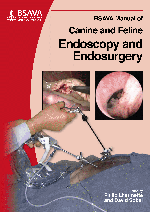
Full text loading...

PLEASE NOTE THAT A MORE RECENT EDITION OF THIS TITLE IS AVAILABLE IN THE LIBRARY
Whereas the use of flexible endoscopes is largely confined to the gastrointestinal and respiratory tracts, where the ability to follow a tortuous lumen is paramount, rigid endoscopes can be introduced into any appropriate body orifice - and if a suitable orifice can't be found, then the surgeon can make one. Laparoscopy and thoracoscopy have challenged the traditional paradigms in human surgery and have revolutionized the treatment of many common conditions, such as gallbladder disease, reproductive tract disorders, bowel cancer and heart disease. This chapter examines Health and safety considerations; Anaesthetic considerations; Patient positioning; Insufflation; Choice of endoscope; Special considerations for endosurgery; Portal placement; Procedure; Dissection and haemostasis; Suction and irrigation; Specimen retrieval; Knot tying techniques; Closure; and Postoperative care.
Rigid endoscopy and endosurgery: principles, Page 1 of 1
< Previous page | Next page > /docserver/preview/fulltext/10.22233/9781905319572/9781905319572.7-1.gif

Full text loading...






